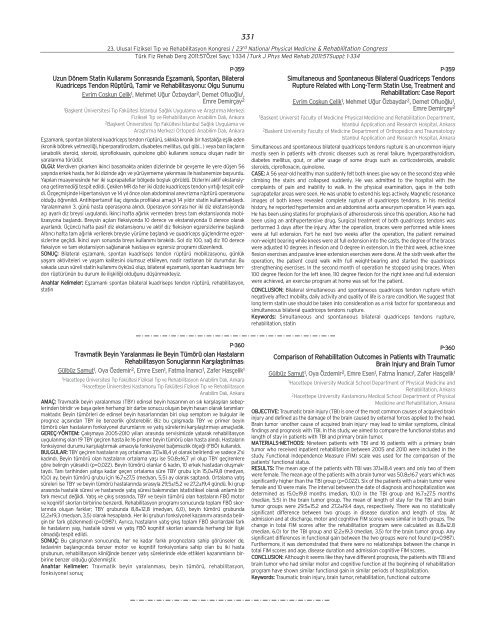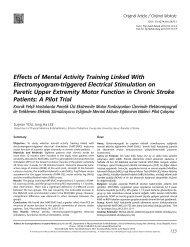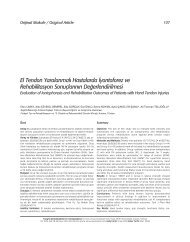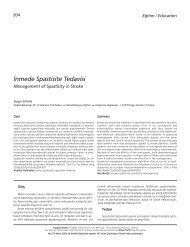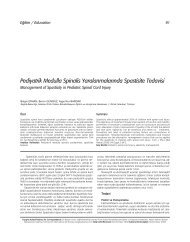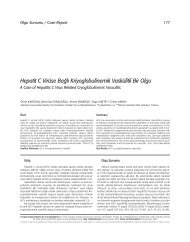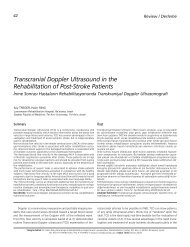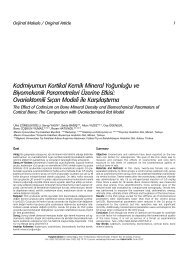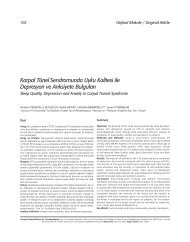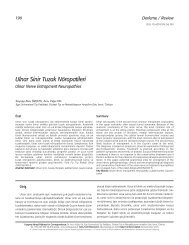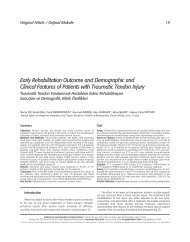Postmenopozal Kad›nlarda Vücut Kitle ‹ndeksinin ... - FTR Dergisi
Postmenopozal Kad›nlarda Vücut Kitle ‹ndeksinin ... - FTR Dergisi
Postmenopozal Kad›nlarda Vücut Kitle ‹ndeksinin ... - FTR Dergisi
Create successful ePaper yourself
Turn your PDF publications into a flip-book with our unique Google optimized e-Paper software.
P-359<br />
Uzun Dönem Statin Kullan›m› Sonras›nda Eflzamanl›, Spontan, Bilateral<br />
Kuadriceps Tendon Rüptürü, Tamir ve Rehabilitasyonu: Olgu Sunumu<br />
Evrim Coflkun Çelik 1, Mehmet U¤ur Özbaydar 2, Demet Ofluo¤lu 1,<br />
Emre Demirçay 2<br />
1Baflkent Üniversitesi T›p Fakültesi ‹stanbul Sa¤l›k Uygulama ve Araflt›rma Merkezi<br />
Fiziksel T›p ve Rehabilitasyon Anabilim Dal›, Ankara<br />
2Baflkent Üniversitesi T›p Fakültesi ‹stanbul Sa¤l›k Uygulama ve<br />
Araflt›rma Merkezi Ortopedi Anabilim Dal›, Ankara<br />
Eflzamanl›, spontan bilateral kuadriceps tendon rüptürü, s›kl›kla kronik bir hastal›¤a efllik eden<br />
(kronik böbrek yetmezli¤i, hiperparatirodizm, diyabetes mellitus, gut gibi.. ) veya baz› ilaçlar›n<br />
(anabolik steroid, steroid, siprofloksasin, quinolone gibi) kullan›m› sonucu oluflan nadir bir<br />
yaralanma türüdür.<br />
OLGU: Merdiven ç›karken ikinci basamakta aniden dizlerinde bir gevfleme ile yere düflen 56<br />
yafl›nda erkek hasta, her iki dizinde a¤r› ve yürüyememe yak›nmas› ile hastanemize baflvurdu.<br />
Yap›lan muayenesinde her iki suprapatellar bölgede boflluk görüldü. Dizlerini aktif ekstansiyona<br />
getiremedi¤i tespit edildi. Çekilen MR da her iki dizde kuadriceps tendon y›rt›¤› tespit edildi.<br />
Özgeçmiflinde Hipertansiyon ve 14 y›l önce olan abdominal anevrizma rüptürü operasyonu<br />
oldu¤u ö¤renildi. Antihipertansif ilaç d›fl›nda profilaksi amaçl› 14 y›ld›r statin kullanmaktayd›.<br />
Yaralanman›n 3. günü hasta operasyona al›nd›. Operasyon sonras› her iki diz ekstansiyonda<br />
aç› ayarl› diz breysi uyguland›. ‹kinci hafta a¤›rl›k vermeden breys tam ekstansiyonda mobilizasyona<br />
baflland›. Breysin aç›lar› fleksiyonda 10 derece ve ekstansiyonda 0 derece olarak<br />
ayarland›. Üçüncü hafta pasif diz ekstansiyonu ve aktif diz fleksiyon egzersizlerine baflland›<br />
Alt›nc› hafta tam a¤›rl›k verilerek breysle yürüme baflland› ve quadriceps güçlendirme egzersizlerine<br />
geçildi. ‹kinci ay›n sonunda breys kullan›m› b›rak›ld›. Sol diz 100, sa¤ diz 110 derece<br />
fleksiyon ve tam ekstansiyon sa¤lanarak hastaya ev egzersiz program› düzenlendi.<br />
SONUÇ: Bilateral eflzamanl›, spontan kuadriseps tendon rüptürü mobilizasyonu, günlük<br />
yaflam aktiviteleri ve yaflam kalitesini olumsuz etkileyen, nadir rastlanan bir durumdur. Bu<br />
vakada uzun süreli statin kullan›m› öyküsü olup, bilateral eflzamanl›, spontan kuadriseps tendon<br />
rüptürünün bu durum ile iliflkili¤i oldu¤unu düflünmekteyiz.<br />
Anahtar Kelimeler: Eflzamanl› spontan bilateral kuadriseps tendon rüptürü, rehabilitasyon,<br />
statin<br />
P-360<br />
Travmatik Beyin Yaralanmas› ile Beyin Tümörü olan Hastalar›n<br />
Rehabilitasyon Sonuçlar›n›n Karfl›laflt›r›lmas›<br />
Gülbüz Samut 1, Oya Özdemir 2, Emre Esen 1, Fatma ‹nan›c› 1, Zafer Hasçelik 1<br />
1 Hacettepe Üniversitesi T›p Fakültesi Fiziksel T›p ve Rehabilitasyon Anabilim Dal›, Ankara<br />
2 Hacettepe Üniversitesi Kastamonu T›p Fakültesi Fiziksel T›p ve Rehabilitasyon<br />
Anabilim Dal›, Ankara<br />
AMAÇ: Travmatik beyin yaralanmas› (TBY) edinsel beyin hasar›n›n en s›k karfl›lafl›lan sebeplerinden<br />
biridir ve bafla gelen herhangi bir darbe sonucu oluflan beyin hasar› olarak tan›mlanmaktad›r.<br />
Beyin tümörleri de edinsel beyin hasarlar›ndan biri olup semptom ve bulgular ile<br />
prognoz aç›s›ndan TBY ile benzerlik gösterebilir. Biz bu çal›flmada TBY ve primer beyin<br />
tümörü olan hastalar›n fonksiyonel durumlar›n› ve yat›fl sürelerini karfl›laflt›rmay› amaçlad›k.<br />
GEREÇ-YÖNTEM: Çal›flmaya 2005-2010 y›llar› aras›nda servisimizde yatarak rehabilitasyon<br />
uygulanm›fl olan 19 TBY geçiren hasta ile 16 primer beyin tümörü olan hasta al›nd›. Hastalar›n<br />
fonksiyonel durumu karfl›laflt›rmak amac›yla fonksiyonel ba¤›ms›zl›k ölçe¤i (FBÖ) kullan›ld›.<br />
BULGULAR: TBY geçiren hastalar›n yafl ortalamas› 37,1±18,4 y›l olarak belirlendi ve sadece 2’si<br />
kad›nd›. Beyin tümörü olan hastalar›n ortalama yafl› ise 50,8±16,7 y›l olup TBY geçirenlere<br />
göre belirgin yüksekti (p=0,022). Beyin tümörü olanlar 6 kad›n, 10 erkek hastadan oluflmaktayd›.<br />
Tan› tarihinden yat›fla kadar geçen ortalama süre TBY grubu için 15,0±19,8 (medyan,<br />
10,0) ay, beyin tümörü grubu için 16,7±27,5 (medyan, 5,5) ay olarak saptand›. Ortalama yat›fl<br />
süreleri ise TBY ve beyin tümörü hastalar›nda s›ras›yla 29,5±15,2 ve 27,2±19,4 gündü. ‹ki grup<br />
aras›nda hastal›k süresi ve hastanede yat›fl süresi bak›m›ndan istatistiksel olarak anlaml› bir<br />
fark mevcut de¤ildi. Yat›fl ve ç›k›fl s›ras›nda, TBY ve beyin tümörü olan hastalar›n FBÖ motor<br />
ve kognitif skorlar› birbirine benzerdi. Rehabilitasyon program› sonucunda toplam FBÖ skorlar›nda<br />
oluflan farklar; TBY grubunda 8,8±12,8 (medyan, 6,0), beyin tümörü grubunda<br />
12,2±19,3 (medyan, 3,5) olarak hesapland›. Her iki grubun fonksiyonel kazan›m› aras›nda belirgin<br />
bir fark gözlenmedi (p=0,987). Ayr›ca, hastalar›n yat›fl-ç›k›fl toplam FBÖ skorlardaki fark<br />
ile hastalar›n yafl›, hastal›k süresi ve yat›fl FBÖ kognitif skorlar› aras›nda herhangi bir iliflki<br />
olmad›¤› tespit edildi.<br />
SONUÇ: Bu çal›flman›n sonucunda, her ne kadar farkl› prognozlara sahip görünseler de,<br />
tedavinin bafllang›c›nda benzer motor ve kognitif fonksiyonlara sahip olan bu iki hasta<br />
grubunun, rehabilitasyon klini¤inde benzer yat›fl sürelerinde elde ettikleri kazan›mlar›n birbirine<br />
benzer oldu¤u gözlenmifltir.<br />
Anahtar Kelimeler: Travmatik beyin yaralanmas›, beyin tümörü, rehabilitasyon,<br />
fonksiyonel sonuç<br />
331<br />
23. Ulusal Fiziksel T›p ve Rehabilitasyon Kongresi / 23 rd National Physical Medicine & Rehabilitation Congress<br />
Türk Fiz Rehab Derg 2011:57Özel Say›; 1-334 /Turk J Phys Med Rehab 2011:57Suppl; 1-334<br />
P-359<br />
Simultaneous and Spontaneous Bilateral Quadriceps Tendons<br />
Rupture Related with Long-Term Statin Use, Treatment and<br />
Rehabilitation: Case Report<br />
Evrim Coflkun Çelik 1, Mehmet U¤ur Özbaydar 2, Demet Ofluo¤lu 1,<br />
Emre Demirçay 2<br />
1 Baskent Universit Faculty of Medicine Physical Medicine and Rehabilitation Department,<br />
Istanbul Application and Research Hospital, Ankara<br />
2 Baskent University Faculty of Medicine Department of Orthopedics and Traumatology<br />
Istanbul Application and Research Hospital, Ankara<br />
Simultaneous and spontaneous bilateral quadriceps tendons rupture is an uncommon injury<br />
mostly seen in patients with chronic diseases such as renal failure, hyperparathyroidism,<br />
diabetes mellitus, gout, or after usage of some drugs such as corticosteroids, anabolic<br />
steroids, ciprofloxacin, quinolone.<br />
CASE: A 56 year-old healthy man suddenly felt both knees give way on the second step while<br />
climbing the stairs and collapsed suddenly. He was admitted to the hospital with the<br />
complaints of pain and inability to walk. In the physical examination, gaps in the both<br />
suprapatellar areas were seen. He was unable to extend his legs actively. Magnetic resonance<br />
images of both knees revealed complete rupture of quadriceps tendons. In his medical<br />
history, he reported hypertension and an abdominal aorta aneurysm operation 14 years ago.<br />
He has been using statins for prophylaxis of atherosclerosis since this operation. Also he had<br />
been using an antihypertensive drug. Surgical treatment of both quadriceps tendons was<br />
performed 3 days after the injury. After the operation, braces were performed while knees<br />
were at full extension. Fort he next two weeks after the operation, the patient remained<br />
non-weight bearing while knees were at full extension into the casts, the degree of the braces<br />
were adjusted 10 degrees in flexion and 0 degree in extension. In the third week, active knee<br />
flexion exercises and passive knee extension exercises were done. At the sixth week after the<br />
operation, the patient could walk with full weight-bearing and started the quadriceps<br />
strengthening exercises. In the second month of operation he stopped using braces. When<br />
100 degree flexion for the left knee, 110 degree flexion for the right knee and full extension<br />
were achieved, an exercise program at home was set for the patient.<br />
CONCLUSION: Bilateral simultaneous and spontaneous quadriceps tendon rupture which<br />
negatively affect mobility, daily activity and quality of life is a rare condition. We suggest that<br />
long term statin use should be taken into consideration as a risk factor for spontaneous and<br />
simultaneous bilateral quadriceps tendons rupture.<br />
Keywords: Simultaneous and spontaneous bilateral quadriceps tendons rupture,<br />
rehabilitation, statin<br />
P-360<br />
Comparison of Rehabilitation Outcomes in Patients with Traumatic<br />
Brain Injury and Brain Tumor<br />
Gülbüz Samut 1, Oya Özdemir 2, Emre Esen 1, Fatma ‹nan›c› 1, Zafer Hasçelik 1<br />
1 Hacettepe University Medical School Department of Physical Medicine and<br />
Rehabilitation, Ankara<br />
2 Hacettepe University Kastamonu Medical School Department of Physical<br />
Medicine and Rehabilitation, Ankara<br />
OBJECTIVE: Traumatic brain injury (TBI) is one of the most common causes of acquired brain<br />
injury and defined as the damage of the brain caused by external forces applied to the head.<br />
Brain tumor -another cause of acquired brain injury- may lead to similar symptoms, clinical<br />
findings and prognosis with TBI. In this study, we aimed to compare the functional status and<br />
length of stay in patients with TBI and primary brain tumor.<br />
MATERIALS-METHODS: Nineteen patients with TBI and 16 patients with a primary brain<br />
tumor who received inpatient rehabilitation between 2005 and 2010 were included in the<br />
study. Functional Independence Measure (FIM) scale was used for the comparison of the<br />
patients’ functional status.<br />
RESULTS: The mean age of the patients with TBI was 37.1±18.4 years and only two of them<br />
were female. The mean age of the patients with a brain tumor was 50.8±16.7 years which was<br />
significantly higher than the TBI group (p=0.022). Six of the patients with a brain tumor were<br />
female and 10 were male. The interval between the date of diagnosis and hospitalization was<br />
determined as 15.0±19.8 months (median, 10.0) in the TBI group and 16.7±27.5 months<br />
(median, 5.5) in the brain tumor group. The mean of length of stay for the TBI and brain<br />
tumor groups were 29.5±15.2 and 27.2±19.4 days, respectively. There was no statistically<br />
significant difference between two groups in disease duration and length of stay. At<br />
admission and at discharge, motor and cognitive FIM scores were similar in both groups. The<br />
change in total FIM scores after the rehabilitation program were calculated as 8.8±12.8<br />
(median, 6.0) for the TBI group and 12.2±19.3 (median, 3.5) for the brain tumor group. Any<br />
significant differences in functional gain between the two groups were not found (p=0.987).<br />
Furthermore, it was demonstrated that there were no relationships between the change in<br />
total FIM scores and age, disease duration and admission cognitive FIM scores.<br />
CONCLUSION: Although it seems like they have different prognosis, the patients with TBI and<br />
brain tumor who had similar motor and cognitive function at the beginning of rehabilitation<br />
program have shown similar functional gain in similar periods of hospitalization.<br />
Keywords: Traumatic brain injury, brain tumor, rehabilitation, functional outcome


